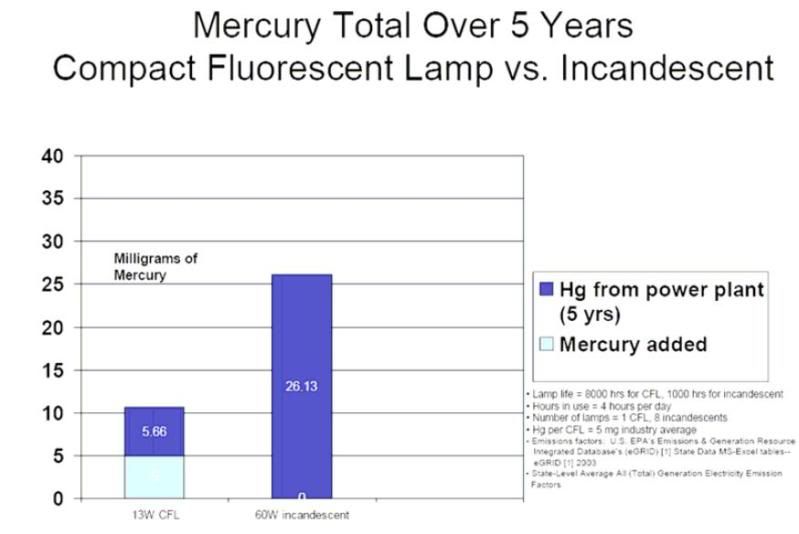- Posts: 15332
- Thank you received: 163
Why Fighting Energy-Efficient Light Bulbs Is So Stupid
- Rick
-

- Mountain Legend
-

The left is angry because they are now being judged by the content of their character and not by the color of their skin.
Please Log in or Create an account to join the conversation.
- The Viking
-

- Mountain Legend
-

- Posts: 9276
- Thank you received: 31
RenegadeCJ wrote: The point is choice. Why should the govt. tell me what bulb to use? I do use some CFL's...but they really don't save much $$ in many locations. The one place they work well is locations where you leave the light on all the time. Really, with CFL's the old axiom of "turn off the light when you leave the room" doesn't apply anymore. Rooms where you enter an leave frequently, the bulbs last about a year.
LJ...the leaded/unleaded argument is exactly opposite. The govt. banned leaded gasoline because lead could hurt people. Now the govt. is forcing us to buy lightbulbs that are KNOWN to hurt people if you break them. And who among us has never broken a lightbulb. Furthermore, I spoke to the people at Home Depot while recycling a large box of dead CFL's and asked them the ratio of recycled bulbs vs. new bulbs sold. They told me in their opinion, less than 5% are recycled, the rest end up in the landfill. Considering our govt. pretends to care about the environment, that is a LOT of mercury entering our air and groundwater due to the thrown away bulbs.
Exactly! Let US the American people decide if we want to buy a less efficient, MUCH less expencise aafer bulb or one that costs a lot more and is poisoning our waters and landfill. 95% of them going there according to what you just posted Renegade. Those who are for all of this mrecury must really not care about our environment very much. Government control and them making our decisions for us is more important.
Please Log in or Create an account to join the conversation.
- The Viking
-

- Mountain Legend
-

- Posts: 9276
- Thank you received: 31
CriticalBill wrote: The government could lower energy cunsumption 100 times more if they forced us to drive smaller cars and penalized us for driving too many miles.... Is that really a stretch?
Aren't they all ready talkng about that in a few states? Taxing per mile driven? THAT would be fun for us who live up here and have to commute! Or are they now going to tell us to move?
Please Log in or Create an account to join the conversation.
- ScienceChic
-

- Mountain Champion
-

- Posts: 15745
- Thank you received: 320
Laws like this are designed to force companies to create products that save you money - they wouldn't otherwise b/c oftentime it requires R&D $ and/or production $. This law doesn't ban incandescents (and take your precious choice from you), as it's been a favorite talking point of those opposed, it mandates improved efficiencies - which if you notice, no one complains about when it comes to washers/dryers/refrigerators/etc. I'm not even going to address CFL's, which many of you focus on, because they were only meant as a stop-gap from incandescent to LED.otisptoadwater wrote: I'm not exactly comfortable with the CFLs because of the mercury content, I wish the LED bulbs were more available and cheaper. I do like the reduced energy costs, I don't like legislation that forces me to buy anything and worse, laws like this one that don't let the consumer decide for themselves.
If you compare the cost of using the number of incandescents over their lifetimes to the lifetime of an equivalent lumen output LED bulb, it's costing you MORE to use the INCANDESCENT. Here are some cost comparisons I posted in the Green Thread a while back, and if you look at the LED bulb price, you'll see that the calculations used prices that are higher than you can purchase them for already (at Home Depot, I've found 40-watt equivalent for $10, 60-watt equivalent for $25, and for the first time at my last trip last week, I saw 75-watt equivalent for $35 - just last year the 40-watt equivalent were $27 so by this time next year 75-watt equivalent could easily be $10, and 100-watt equivalent will be arriving shortly):
SC wrote: I think I read that within a couple of years that $50 should be down to $25 (I currently pay $20-25 for my Home Depot LED bulbs and floods). If they can commercialize the full spectrum LEDs (currently the "white" light put off is created by coloring blue LEDs with yellow phosphorous), then they should go down a lot more.
Cost comparison incandescents vs CFLs vs LEDs
http://www.thesimpledollar.com/2009/02/ ... he-future/
http://www.scribd.com/doc/3222967/Incan ... ED-Savings
Energy Savings Calculator for Replacing Light Bulbs
http://ees2001.wordpress.com/2011/04/01 ... on-safety/
LED vs CFL vs incandescent, no comparison on safetyFrom http://www.thesimpledollar.com/2009/02/ ... he-future/
Comparing Costs
Standard incandescent bulbs...used here has a lifetime of 1,300 hours, so we would need 23 bulbs over the period of this study. I was able to purchase a single incandescent of this type for $0.34, so our total cost for bulbs over 30,000 hours would be $7.82.
As it uses 60 watts, over a period of 30,000 hours, an incandescent bulb would use 1,800,000 watt hours, or 1,800 kilowatt hours. At the current approximate price of $0.10 per kilowatt hour, you would have to pay $180.00 to run an incandescent bulb over this period. Thus, the total cost of a 60 watt incandescent bulb over a 30,000 hour lifespan is $187.82.
LED bulbs The LED bulb used here has a lifetime of 30,000 hours, so we would need only one bulb over the period of this study. Unfortunately, that single bulb has a cost of $119.99.
As it uses 7.5 watts, over a period of 30,000 hours, an LED bulb would use 245,000 watt hours, or 245 kilowatt hours. At the current approximate price of $0.10 per kilowatt hour, you would have to pay $24.50 to run an LED bulb over this period. Thus, the total cost of an LED bulb over a 30,000 hour lifespan is $144.49.
So $187.82 versus $144.49 - not really worth it...but wait! Notice that the bulk of the cost for the LED is their inclusion of the price of the bulb at $119 - they are nowhere near this - $25-$35 depending on brand in stores right now making the actual total cost of an LED bulb over a 30,000 hour lifespan $59.50. So would you rather spend $187.82 or $59.50?
"Now, more than ever, the illusions of division threaten our very existence. We all know the truth: more connects us than separates us. But in times of crisis the wise build bridges, while the foolish build barriers. We must find a way to look after one another as if we were one single tribe.” -King T'Challa, Black Panther
The truth is incontrovertible. Malice may attack it. ignorance may deride it, but in the end, there it is. ~Winston Churchill
Please Log in or Create an account to join the conversation.
- RenegadeCJ
-

- Mountain Legend
-

- Posts: 3724
- Thank you received: 130
As of yet, LED's aren't available in the bulbs I need (getting closer though!). My first attempt at replacing some GU10's with the equivalent LED was a waste. Not enough lumens.
Science Chic-have you replaced 60 watt bulbs from recessed lighting yet? Did you do the conversion, or just buy the bulbs. I've heard you have to replace the trim as well?
The point again....is freedom of choice. If I want to spend $200 powering my old bulbs, whose business is that? Now, if you want to regulate overall power usage...that is different (one I completely disagree with...but that is another story). Why regulate my usage of power for that, but not for other things? I'm not into the govt engineering how we live, as long as we aren't hurting others.
Too bad future generations aren't here to see all the great things we are spending their $$ on!!
Please Log in or Create an account to join the conversation.
- jf1acai
-

- Mountain Legend
-

I don't mind the evolutionary technological process (after all, I'm a geek, and have been buying computers since 1980
Laws like this are designed to force companies to create products that save you money
I disagree. Laws like this are designed to force you to buy what the all knowing government thinks you should buy. The government is NOT interested in saving you money!
Experience enables you to recognize a mistake when you make it again - Jeanne Pincha-Tulley
Comprehensive is Latin for there is lots of bad stuff in it - Trey Gowdy
Please Log in or Create an account to join the conversation.
- The Viking
-

- Mountain Legend
-

- Posts: 9276
- Thank you received: 31
Science Chic wrote:
Laws like this are designed to force companies to create products that save you money - they wouldn't otherwise b/c oftentime it requires R&D $ and/or production $. This law doesn't ban incandescents (and take your precious choice from you), as it's been a favorite talking point of those opposed, it mandates improved efficiencies - which if you notice, no one complains about when it comes to washers/dryers/refrigerators/etc. I'm not even going to address CFL's, which many of you focus on, because they were only meant as a stop-gap from incandescent to LED.otisptoadwater wrote: I'm not exactly comfortable with the CFLs because of the mercury content, I wish the LED bulbs were more available and cheaper. I do like the reduced energy costs, I don't like legislation that forces me to buy anything and worse, laws like this one that don't let the consumer decide for themselves.
If you compare the cost of using the number of incandescents over their lifetimes to the lifetime of an equivalent lumen output LED bulb, it's costing you MORE to use the INCANDESCENT. Here are some cost comparisons I posted in the Green Thread a while back, and if you look at the LED bulb price, you'll see that the calculations used prices that are higher than you can purchase them for already (at Home Depot, I've found 40-watt equivalent for $10, 60-watt equivalent for $25, and for the first time at my last trip last week, I saw 75-watt equivalent for $35 - just last year the 40-watt equivalent were $27 so by this time next year 75-watt equivalent could easily be $10, and 100-watt equivalent will be arriving shortly):
SC wrote: I think I read that within a couple of years that $50 should be down to $25 (I currently pay $20-25 for my Home Depot LED bulbs and floods). If they can commercialize the full spectrum LEDs (currently the "white" light put off is created by coloring blue LEDs with yellow phosphorous), then they should go down a lot more.
Cost comparison incandescents vs CFLs vs LEDs
http://www.thesimpledollar.com/2009/02/ ... he-future/
http://www.scribd.com/doc/3222967/Incan ... ED-Savings
Energy Savings Calculator for Replacing Light Bulbs
http://ees2001.wordpress.com/2011/04/01 ... on-safety/
LED vs CFL vs incandescent, no comparison on safetyFrom http://www.thesimpledollar.com/2009/02/ ... he-future/
Comparing Costs
Standard incandescent bulbs...used here has a lifetime of 1,300 hours, so we would need 23 bulbs over the period of this study. I was able to purchase a single incandescent of this type for $0.34, so our total cost for bulbs over 30,000 hours would be $7.82.
As it uses 60 watts, over a period of 30,000 hours, an incandescent bulb would use 1,800,000 watt hours, or 1,800 kilowatt hours. At the current approximate price of $0.10 per kilowatt hour, you would have to pay $180.00 to run an incandescent bulb over this period. Thus, the total cost of a 60 watt incandescent bulb over a 30,000 hour lifespan is $187.82.
LED bulbs The LED bulb used here has a lifetime of 30,000 hours, so we would need only one bulb over the period of this study. Unfortunately, that single bulb has a cost of $119.99.
As it uses 7.5 watts, over a period of 30,000 hours, an LED bulb would use 245,000 watt hours, or 245 kilowatt hours. At the current approximate price of $0.10 per kilowatt hour, you would have to pay $24.50 to run an LED bulb over this period. Thus, the total cost of an LED bulb over a 30,000 hour lifespan is $144.49.
So $187.82 versus $144.49 - not really worth it...but wait! Notice that the bulk of the cost for the LED is their inclusion of the price of the bulb at $119 - they are nowhere near this - $25-$35 depending on brand in stores right now making the actual total cost of an LED bulb over a 30,000 hour lifespan $59.50. So would you rather spend $187.82 or $59.50?If anyone would like to see how they look, you're welcome to come to my house! (I can't tell the difference - the warmth of the light is identical, and now that they're coming out with brighter lumen bulbs, I can finish replacing out my CFL's).
So do you not care that up to 95% are ending up in landfills with the Mercury that environmentalists fight so hard against, poisoning our land and water?
Please Log in or Create an account to join the conversation.
- BearMtnHIB
-

- Mountain Legend
-

- Posts: 2464
- Thank you received: 0
Turns out that many of my CFL's did not last as long as advertised. In some cases, they lasted only 25% of the time listed on the package. I returned some to walmart and some to home depot- they nearly did not take them back, wanting me to send them back to the manufacturer. I told them I bought them at this walmart- not at the manufacturer in detroit or whereever.
I have found that in most cases - they do not last as long as they say- my savings to date have been questionable at best- and might have cost me more to go with the CFL's.
There are a few applications for the old light bulbs that CFL's and LED's simply can not address. You can not dim a CFL- that's one problem. Those lights that I want to dim still require the old tried and true bulb type.
I also use the old bulbs by taking advantage of the "inefficiency"- since 90% of the energy results in heat- I use them in a few select locations to keep piping from freezing. Just place a bulb under or beside that spot where a pipe freezes can save thousands in repair bills. Just switch them on during those really cold nights!
One can also place a bulb under a car engine block in the winter during those -20 nights and keep an engine block up to 30 degrees warmer. I've used this trick and been able to start a vehicle that otherwise would not have started.
The point is that the government should not be involved in making my choices for me. They assume we are just children - I assume they are just bent on telling us what to do. Let the free market change us in a "green way". If it's really green and saves us money, we will make the best choices ourselves, and we can give all those in government who think they know better than we do an early retirement.
Please Log in or Create an account to join the conversation.
- Something the Dog Said
-

- Mountain Legend
-

- Posts: 3444
- Thank you received: 11
"Remember to always be yourself. Unless you can be batman. Then always be batman." Unknown
Please Log in or Create an account to join the conversation.
- pineinthegrass
-

- Mountain Legend
-

- Posts: 2836
- Thank you received: 25
Since CFL's use less energy, they actually contribute less mercury to the environment than incandescent bulbs do, even if you break the bulb when you throw it away...
http://www.nema.org/gov/env_conscious_design/upload/Recycling%20Household%20CFLs.%2009%2007.pdf
So can we drop this mercury arguement?
So far as the story posted by swampfish goes, it's very vague. It provides no numbers for the amounts measured, nor does it even state what toxins were found. I've tried to find the original report, but all my searches come up with are thousands of copies of that same story, mostly at conservative web sites.
Let's face it, most modern materials can contain toxins and carcinogens. Hamburgers contain carcinogins and most of us eat them. Has anyone eaten a CFL lately?
http://www.rawfoodexplained.com/cancers-tumors/part-ii/carcinogens-in-food.html
I'd like to see the actual report the article refers to before I'd draw any conclusions.
And BTW, if you are reading this thread on your notebook or with your desktop LCD monitor, most of those have a form of a CFL in them to back light the screen (newer ones offer LED which still cost more). So if you don't want a CFL in your lamp since you worry it's not safe, you better stop using your computer too.
Please Log in or Create an account to join the conversation.







